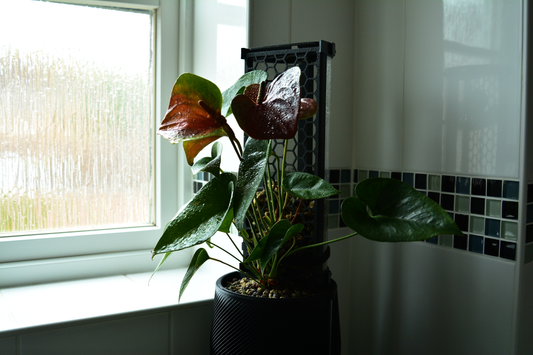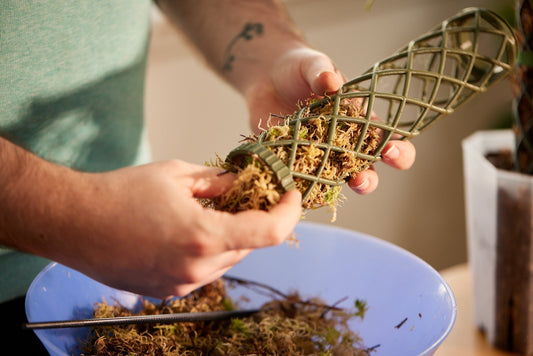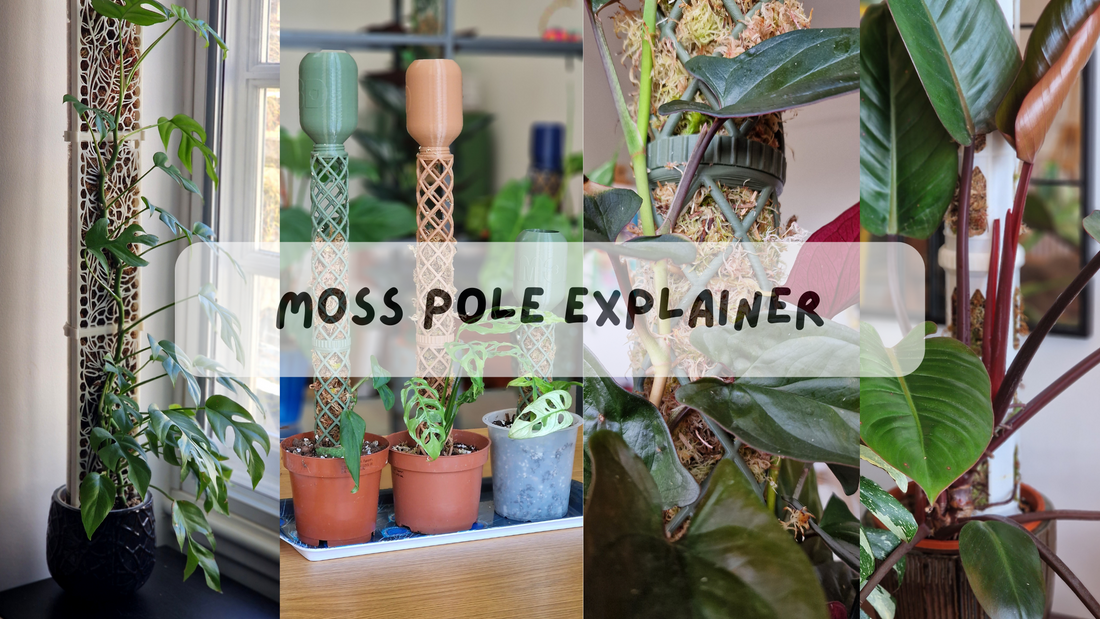
Best moss poles for indoor plants - Moss pole guide
Share
Exploring the world of moss poles can get confusing. Ultimately, the choice of the best moss pole is down to your individual plant goals, style, and even budget. The good news is that you have lots of options, the bad news is that you have lots of options...
A moss pole is not just about looking good, it's about creating a healthy growth environment for your plant. Moss poles provide vital support for climbing and vining plants while boosting humidity levels and promoting root health and maturity. They can also be channels to provide your plants with nutrients.
However, with loads of options available in the moss pole market, choosing the right plant support can be overwhelming. In this guide, we'll delve into the best moss poles suited for your indoor plants, considering factors like material, aesthetics, size, durability, and eco-friendliness. (Here's why we think plant parent beginners will love moss poles too).

Different kinds of moss poles
We wrote a guide to moss poles here that outlines the main types:
Coco coir moss poles are made from coconut husks, a by-product of the coconut milk industry. They offer low water retention properties, focusing instead on providing an organic surface for climbing plants to grip. Most importantly, coco coir poles are biodegradable, ensuring minimal environmental impact (though some stackable options feature a PVC tube that is not without it's environmental cost). They have nearly monopolised the moss pole market, by virtue of being the cheapest type of moss pole, and these are often sold with indoor plants, especially Monstera Deliciosa varieties.

Manufactured sphagnum moss poles such as ours do indeed employ moss, as a moss pole should. A simple concept, these are usually shaped like a rigid cage which can be filled with some moisture retaining substrate. Sphagnum moss is renowned for its exceptional water retention capabilities, ensuring consistent moisture levels around the plant's aerial roots. These poles also create a humid microclimate, mimicking the natural habitat of tropical plants. Additionally, sphagnum moss is known for its antimicrobial properties, deterring the growth of harmful pathogens. As sphagnum is organic matter, it is also rich in micronutrients which can be absorbed far closer to the growth point of your tall climber. We make our moss poles out of biodegradable PLA and 3D print them with minimal production waste.

Bamboo moss poles (trellis): Bamboo supports strike a balance between durability and sustainability. Harvested from renewable bamboo sources, these poles offer sturdy support for heavy climbers like Monsteras and Philodendrons. Bamboo poles are resistant to rot and degradation, ensuring long-lasting support for your plants. With their natural aesthetic appeal, bamboo poles look nice, but don't offer a lot of the benefits some other moss poles do.
Metal or PVC moss poles: Moss poles can be pretty simple constructions, just a metal or PVC core, covered with moss held in place with fishing line. Metal-core moss poles can be quite sturdy, but PVC ones tend to be less rigid.
Sheet plastic moss poles are growing in popularity, as they provide a very cost-effective method for enclosing moss into a channel shape with an open face, which then faces the plants aerial roots. These can be made from biodegradable materials, shipped flat for cheap, and then folded into shape by the plant parent. While it is possible to extend these channels, their lack of rigid support means you will always need to brace them if you plan on extending your moss pole.
DIY moss poles: For the plant enthusiasts, DIY moss poles present an opportunity to make your own plant support. You can use materials you might have around for other projects like PVC pipes, chicken wire, twine, or wire fencing - combined with sphagnum moss, you can craft moss poles tailored to your indoor garden. DIY moss poles offer flexibility in size and design, accommodating various plant species and growth patterns. Plus, they allow you to experiment with different materials! YouTube has some great DIY moss pole tutorials.
What are moss poles for?

Moss poles encourage healthy plants, bigger leaves, and more variegation in variegated plants. Moss poles help climbing plants by supporting their natural climbing or vining tendencies.
Here are the primary benefits of using moss poles:
- Support: Many houseplants, such as Philodendrons, Monsteras, and Pothos, naturally climb trees in the wild. A moss pole provides a vertical structure for these plants to attach to and climb upwards, promoting more natural growth patterns.

- Aerial roots: Climbing plants often produce aerial roots that seek out surfaces to latch onto. Moss poles offer an ideal surface for these roots to dig into, which can help the plant to secure itself as it grows taller and potentially improve its health and vitality.

- Humidity: The moss or coco coir material retains moisture, creating a microenvironment around the pole that increases humidity. This is beneficial for tropical plants that thrive in higher humidity conditions, helping to mimic their natural environment.
- Larger leaves: For some plants, providing a structure to climb can encourage the production of larger leaves. Plant maturity is also tied to the development of its root system: more and bigger roots = more mature plants with bigger and more fenestrated leaves. In nature, as plants climb towards the light through the canopy, their leaves often increase in size. A moss pole can help replicate this effect indoors.
- Space efficiency: Vertical gardening with moss poles is a space-saving solution, allowing gardeners to cultivate taller plants without needing a broader base area. This is especially useful in indoor settings or small outdoor areas.
- Aesthetics: Beyond the practical benefits, using moss poles can also enhance the visual appeal of the plant display. It adds height and structure, making the plants more of a focal point in home décor.
- Nutrients: If you use the right kind of moss, you will also be giving your plants vital nutrients.

What to consider when selecting a moss pole?
When selecting a moss pole for your plants, there are several factors to consider, so here are some key considerations:
Size & Height
Consider both the height and the diameter of the pole. The height of the moss pole must accommodate future growth, and the diameter will define the surface area for climbing roots to attach, as well as the volume of moss that can be filled with root growth. A wider diameter will also be more rigid as the height increases, meaning more stability. (For reference, our most popular size, the XL line, is 6 cm in diameter, and the XXL line is 8 cm).
We wrote a guide on what moss pole size to select over here. With stackable and extendable moss poles, your moss pole can grow with your plant.
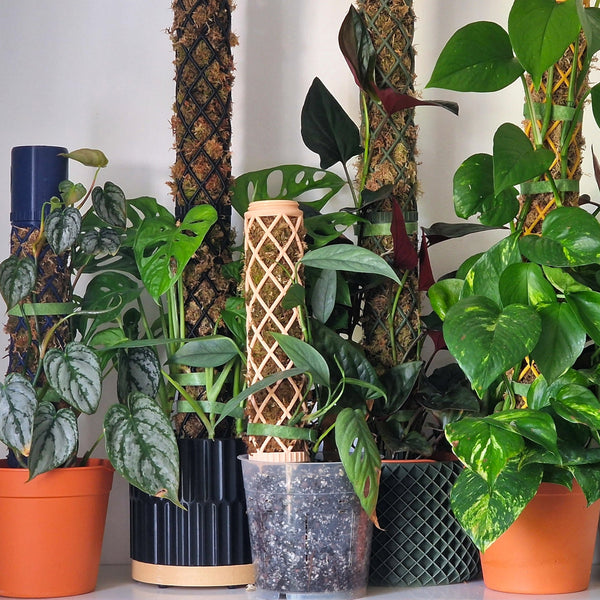
Material
Moss poles are typically made from sphagnum moss or coco coir. Sphagnum moss retains moisture well, which can be beneficial for humidity-loving plants, but it may break down faster over time. Coco coir is more durable and retains some moisture, but it won't hold water as effectively as sphagnum moss. Consider the specific needs of your plant and your watering habits when choosing.
Structure and stability
Ensure that the core is sturdy enough to support your plant's weight as it grows. A stronger core is particularly important for heavier plants or those that will grow significantly over time. (Our D-shaped moss pole line has been tested by stacking 6 modules unsupported: 180 cm/6 feet).
Future-proofing
Some moss poles are designed to be extendable, allowing you to add more length as your plant grows. This feature can be very useful for plants that grow quickly or reach substantial heights, saving you the trouble of replacing the pole frequently. We offer all our moss poles as stackable and extendable models.
Anchoring
Consider how the moss pole will be buried or placed in the plant's pot. It should be stable and secure to support the plant without tipping over. Some poles come with ways to anchor them firmly into the soil, while others might require additional support or ties. Well hydrated moss is quite heavy, and your moss pole will quickly become top-heavy as it grows, regardless of how well it is buried in the soil.
We designed a wall mount bracket for our moss poles for extra stability when they start to stack up high - free download here. The bracket will likely work with many similar size moss poles.

Aesthetics
While the primary function of a moss pole is to support and benefit the plant, its appearance is also worth considering. Choose a moss pole that complements your plant and fits well with your home décor or garden aesthetics. (Moss pole colour theory).
Watering
Because the material of the moss pole should retain moisture, consider how this will affect the watering needs of your plant, as excess water from the moss can easily filter down into your soil, oversaturating it with water and causing root rot.
Well-draining soil is a must if you plan to keep a moist moss pole over your soil. You will also need to keep your moss poles hydrated on a regular basis. We designed an adjustable slow-drip cap that fits just about all our moss poles, but even so, you will need to keep it filled and cleaned. (Note: adding a drip cap technically makes the pole self-watering, but we find that term a bit misleading. No moss pole is fully self-watering in the sense that you can just set it and forget it forever).
Environmental Impact
For those concerned about sustainability, like us, consider the environmental impact of the materials used. You should strive to use sustainably sourced moss and avoid using single-use plastics.
Our biosourced plastics can be broken down and composted after they have completed their use cycle, but will provide you with many years of stability and support before that!
What moss poles paired with what plants?
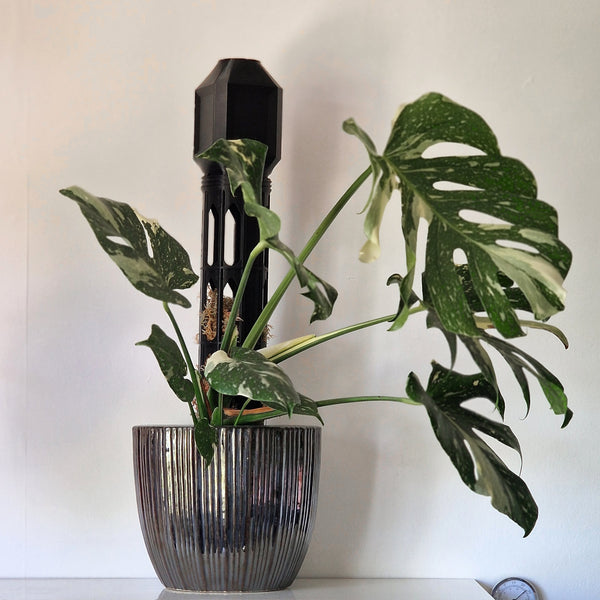
Moss poles can be paired with a variety of climbing or vining plants, especially those that benefit from vertical support and higher humidity. Here's a guide to what types of plants typically pair well with moss poles, and any specific considerations for each:
1. Monstera, in just about any of its varieties

- Why: Monstera plants naturally climb trees in their rainforest habitats, using aerial roots to attach to the bark. A moss pole mimics this environment, encouraging the plant to produce larger, more fenestrated leaves.
- Consideration: Choose a sturdy moss pole, as Monsteras can have thick heavy stems. They also put out some pretty massive aerial roots, so you'll need a large diameter pole to contain them. You can also use moss poles on smaller Monstera types.
- Moss Pole pairing:
- Monstera Deliciosa and its variations (Thai Constellation, Aurea, Albo) - Large diameter sturdy poles such as the XXL and the Turra.
- Monstera Adansonii and its variations - These fast growers can reach incredible heights, choose an XL or D-Shaped Pole
- Monstera Minima, seen below on the Barbara, a variation of the D-shaped line.
- Monstera Dubia, Peru, Standelyana - you can create beautiful green walls with a single faced pole like the D-Shaped Pole
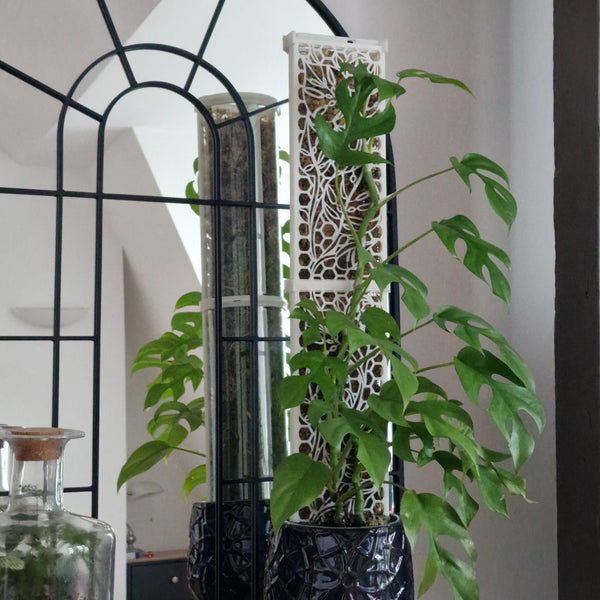
Moss pole Monstera training tips here.
2. Philodendrons
- Why: Many Philodendron species are climbers and appreciate the support of a moss pole. They use their aerial roots to grip onto the pole, which can encourage larger leaf growth.
- Consideration: Some Philodendrons can grow very tall, so consider an extendable moss pole.

- Moss Pole pairing:
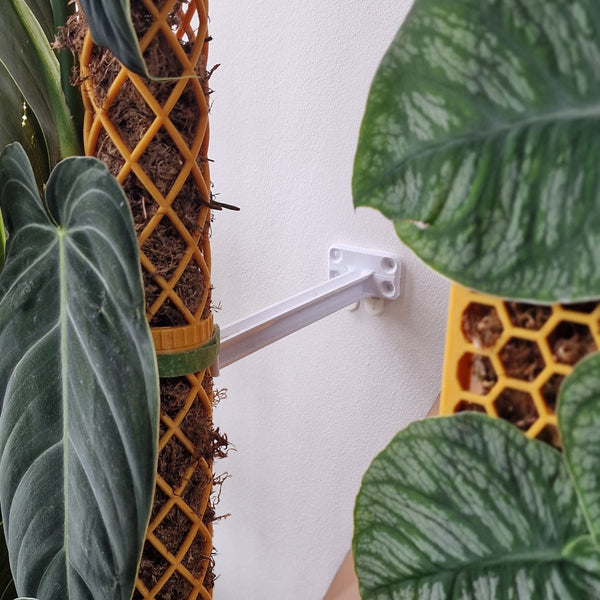
3. Pothos (Epipremnum aureum)
- Why: While often grown as trailing plants, Pothos can also climb and will attach to a moss pole using its aerial roots. This can encourage the plant to produce bigger leaves.
- Consideration: A standard moss pole is usually sufficient for Pothos, but ensure it's inserted securely in the pot.
- Moss Pole pairing: an XL pole is usually sufficient to encourage growth.
4. Syngonium (Arrowhead Plant)

- Why: Syngoniums are natural climbers and will use a moss pole to support their growth upwards, which can result in a fuller and taller plant.
- Consideration: They don't usually require a very tall pole, but the pole should be moist to help the aerial roots attach.

- Moss Pole pairing: an XL pole is usually sufficient to encourage growth.
5. Hoya
- Why: Some climbing Hoya species can benefit from a moss pole, using it to support their twining growth habit and potentially encouraging longer vine growth.
- Consideration: Hoyas prefer not to have constantly wet roots or bases, so ensure the moss pole does not overly increase the pot's moisture level for these plants.
6. Climbing Ficus
- Why: Ficus plants, especially the climbing/shrubby varieties, can attach to and climb up moss poles, mimicking their natural tendency to climb trees.
- Consideration: These plants might require a sturdier pole, especially as they grow larger and heavier.
- Moss Pole pairing: a flat faced pole such as the D-Shaped Pole will develop into a fully green wall.
General tips:
- Moisture: Consider the moisture preference of the plant. Moss poles are great for plants that thrive in high humidity but might not be suitable for plants that prefer dry conditions.
- Habit: The plant's growth habit (climbing vs. trailing) can dictate the need for a moss pole and the type that's best suited to it.
- Aesthetics: Some people choose moss poles based on aesthetic preferences, aiming to match the look of the pole with the plant and the surrounding decor.
When selecting a moss pole for a specific plant, consider the plant's natural habitat and growth patterns to choose a pole that best supports its health and growth.
Investing in high-quality moss poles is great for the well-being of your indoor plants. Whether you opt for easy coco coir poles, moisture-retentive sphagnum moss poles, durable bamboo poles, or embark on a DIY journey, providing adequate support is crucial for fostering healthy growth. Remember, with the right support, your plants can thrive and flourish!


